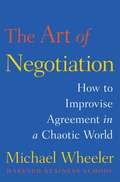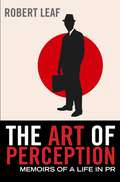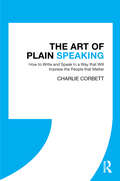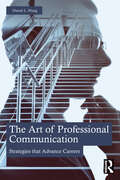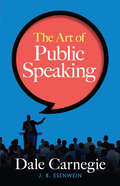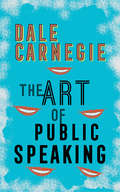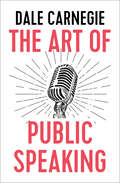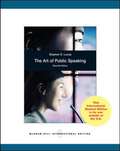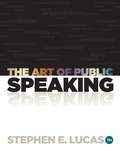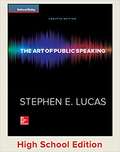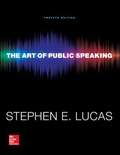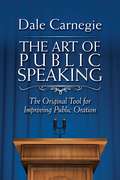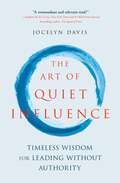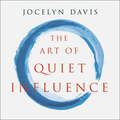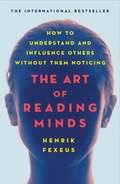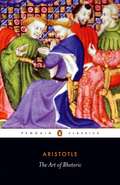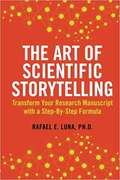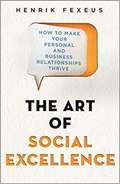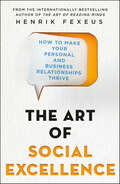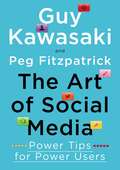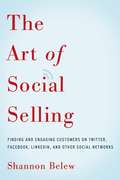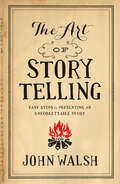- Table View
- List View
The Art of Negotiation
by Michael WheelerA member of the world-renowned Program on Negotiation at Harvard Law School introduces the powerful next-generation approach to negotiation. For many years, two approaches to negotiation have prevailed: the "win-win" method exemplified in "Getting to Yes" by Roger Fisher, William Ury, and Bruce Patton; and the hard-bargaining style of Herb Cohen's "You Can Negotiate Anything. " Now award-winning Harvard Business School professor Michael Wheeler provides a dynamic alternative to one-size-fits-all strategies that don't match real world realities. "The Art of Negotiation" shows how master negotiators thrive in the face of chaos and uncertainty. They don't trap themselves with rigid plans. Instead they understand negotiation as a process of exploration that demands ongoing learning, adapting, and influencing. Their agility enables them to reach agreement when others would be stalemated. Michael Wheeler illuminates the improvisational nature of negotiation, drawing on his own research and his work with Program on Negotiation colleagues. He explains how the best practices of diplomats such as George J. Mitchell, dealmaker Bruce Wasserstein, and Hollywood producer Jerry Weintraub apply to everyday transactions like selling a house, buying a car, or landing a new contract. Wheeler also draws lessons on agility and creativity from fields like jazz, sports, theater, and even military science.
The Art of Non-Conversation: A Re-examination of the Validity of the Oral Proficiency Interview
by Marysia JohnsonThe purpose of this book is to provide answers to two fundamental questions. The first is a practical one, and it represents the main focus of the book: Is the Oral Proficiency Interview a valid instrument for assessing language speaking proficiency? The second is a theoretical one: What is speaking ability? (that is, speaking ability that exists independently of testing instruments).
The Art of Perception: Memoirs of a Life in PR
by Robert LeafRobert Leaf is the father of modern international public relations and this is the memoir of a man who has been at the forefront of the PR industry for almost 50 years The Art of Perception is the memoir of Robert Leaf, the man who is considered to be the all-time leader in the field of international public relations. As the international CEO of Burson-Marsteller, which became the world's largest PR firm during his tenure, he was the first executive to bring PR to the Soviet Union during the Cold War and established the first official Chinese government PR firm. He started the first international PR firm in the Middle East and opened offices throughout the world. He has advised governments, major corporations, and leading individuals, and has been involved in some of the biggest news stories of the time. Now, in a changing world of 24-hour news cycles in which global disasters are shared on the most personal levels and events make it from smartphone to headline news in seconds, the need to manage perceptions has never been more essential for corporations and individuals. In a memoir that is as entertaining as it is informative, Leaf shares his unique experiences in a book that is essential reading for communicators, business professionals, and anyone who would like to improve their skills in the art of managing perceptions.
The Art of Plain Speaking: How to Write and Speak in a Way that Will Impress the People that Matter
by Charlie CorbettThis is a guide for anyone who wants to connect better with people in the workplace by speaking clearly and with purpose. It is a result of five years at Charlie Corbett’s consultancy, Bullfinch Media, where he helped convince executives that speaking plainly, thoughtfully, and behaving with humanity, is the best way to win business, boost morale and advance careers. It provides carefully detailed wisdom on how to write well, speak publicly and stand out in your job, as well as how to craft compelling communications, make the best of social media and handle the press. The Art of Plain Speaking aims to improve the experience faced by many in the modern workplace, a world where senior management are entirely absent from the shop floor – replaced by indecipherable emails from HR – and where people speak in esoteric corporate riddles, believing that sounding clever is more productive than speaking clearly.
The Art of Professional Communication: Strategies that Advance Careers
by Daniel PlungGoing beyond the mechanics of professional communication, this book combines insights into the overlooked implicit demands of corporate communication challenges with the proven strategies and techniques that distinguish professionals as capable communicators and candidates for promotion.The practical strategies offered in this book represent professional communication principles filtered through the lens of the author’s 40-year career, that enabled him to rise from an initial assignment as a technical editor to positions of senior management directing large, diverse business and technical organizations. Here, he has collected into one resource the reasoned and disciplined decision-making processes, tools, and techniques essential to craft communications, precisely attuned to the explicit and implicit expectations of each assignment and supported by a structure and presentation logic that delivers a totally responsive and accurately targeted product. This is an essential guide for all levels of professionals who recognize the need to distinguish themselves within a highly competitive career environment.Business professionals and instructors in corporate training programs, supervisors and managers, and students in professional communication programs will welcome this deep dive into the real-world challenges and opportunities in professional communication and the role effective communication plays in career advancement.
The Art of Public Speaking
by Dale Carnegie J. Berg EsenweinA pioneer in the field of self-help, Dale Carnegie distilled his experiences as a salesman and lecturer in his first guide to successful speech-making, The Art of Public Speaking. This predecessor to his bestseller, How to Win Friends and Influence People, was co-written with J. B. Esenwein. Its direct, practical advice for emphasizing ideas for easy comprehension and high impact ranges from finding an appropriate rhythm to conquering stage fright.Avoiding the use of tricks and shortcuts, the authors suggest methods for developing one's thoughts in order to form an original, authentic manner of speaking. They advise speakers to practice their presentation skills, offering useful tips for speech-making in both personal and professional situations. First published in 1915, this classic continues to encourage people from all walks of life to overcome their self-consciousness and increase their effectiveness and comfort as public speakers.
The Art of Public Speaking
by Dale CarnegieA pioneer in the field of self-help, Dale Carnegie distilled his experiences as a salesman and lecturer in this first guide to successful speech-making. The Art of Public Speaking is direct, practical advice for emphasizing ideas for easy comprehension and high impact ranges from finding an appropriate rhythm to conquering stage fright.Avoiding the use of tricks and shortcuts, the author suggests methods for developing one's thoughts in order to form an original, authentic manner of speaking. He advises speakers to practice their presentation skills, offering useful tips for speech-making in both personal and professional situations. First published in 1915, this classic continues to encourage people from all walks of life to overcome their self-consciousness and increase their effectiveness and comfort as public speakers.Penguin Random House Canada is proud to bring you classic works of literature in e-book form, with the highest quality production values. Find more today and rediscover books you never knew you loved.
The Art of Public Speaking
by Dale CarnegieThe bestselling author of How to Win Friends and Influence People shares the essentials for public speaking in this classic self-help guide.Good oral communication skills are critical in life. Whether you&’re speaking to an audience of one at a party or one hundred at a business conference, you must be able to get your point across effectively. In order to do that, you need a worthwhile topic and the knowledge of what makes a great public speaker.In The Art of Public Speaking, authors Dale Carnegie and J. Berg Esenwein lay out what readers need to improve their communication skills in both personal and professional settings. They offer advice on a multitude of topics, including overcoming stage fright, avoiding monotony, and showing enthusiasm. Learn about methods of delivery and the power of pitch, pace, and gestures. They also discuss strengthening your memory and expanding your vocabulary.The Art of Public Speaking was first published in 1915, but its message is still relevant today. With the help of practice and the lessons herein, readers will be on their way to wowing audiences.
The Art of Public Speaking
by Stephen E. LucasPresenting to the class or delivering a speech to a large crowd can create anxiety, fear, and stress. Adapted from the best-selling text, The Art of Public Speaking, First Canadian Edition, will equip readers with tools and strategies to allay their fears while captivating audiences in various contexts, from the classroom to the workplace. Stressing the importance of public speaking in both the academic career and in the workplace is a challenge as students often don't realize that writing for the ear is different than writing for the eye. The scope of the text includes different public speaking situations (e. g. , business meetings, web casting, teleconferencing, meetings, trade shows, etc. ). The Art of Public Speaking walks readers through the steps and skills involved in crafting and delivering effective oral presentations. Bringing the theory to life, the authors include numerous engaging Canadian examples relevant to a variety of disciplines and careers. Examples and speeches draw on current topical issues (free trade, corporate spying, genetically modified food, etc. ) that are important to Canadians and to post-secondary students. Whether a novice or a professional, every student will learn how to be a better public speaker through Lucas' clear explanations and thorough coverage. Ultimately, this text helps students learn practical oral communication skills that enable them to navigate through life with greater confidence to achieve personal and professional success.
The Art of Public Speaking
by Stephen LucasThe Art of Public Speaking 11e continues to define the art of being the best by helping today's students become capable, responsible speakers and thinkers. With a strong focus on the practical skills of public speaking and grounded in classical and contemporary theories of rhetoric, The Art of Public Speaking offers full coverage of all major aspects of speech preparation and presentation. Utilizing the full suite of resources, students learn to internalize the principles of public speaking, build confidence through speech practice, and prepare for success in the classroom and beyond. With the new Enhanced Speech Capture in Connect Lucas, instructors now have the ability to evaluate live speeches using a customizable rubric in the classroom. Instructors may also upload speech videos on students' behalf to create and manage true peer review assignments. With its ground-breaking adaptive learning system, Connect LucasTM also helps students "know what they know," while guiding them to experience and learn important concepts that they need to know to succeed. With McGraw-Hill CreateTM, instructors can now customize their Lucas 11e textbook to the section level, selecting and arranging only the sections covered in the course. The new Create system will automatically repaginate and re-number chapters, sections, graphs, and illustrations, based on how the instructor chooses to arrange them. This deep level of customization guarantees that students pay only for the content covered in the course.
The Art of Public Speaking (10th Edition)
by Stephen LucasIn preparing this edition, I have retained what readers have identified as the main strengths of previous editions. The book continues to be informed by classical and contemporary theories of rhetoric but does not present theory for its own sake. Keeping a steady eye on the practical skills of public speaking, it offers full coverage of all major aspects of speech preparation and presentation.
The Art of Public Speaking 12th Edition
by Stephen LucasThe Art of Public Speaking personalizes learning for every student no matter who they are or where they are, ensuring that they come to your public speaking class confident, prepared with the principle foundations, and ready to participate in your teaching and coaching. Connect is the only integrated learning system that empowers students by continuously adapting to deliver precisely what they need, when they need it, and how they need it, so that your class time is more engaging and effective.
The Art of Public Speaking: The Original Tool for Improving Public Oration
by Dale CarnegieBoost Your Skills and Confidence with This Classic GuideDo you have trouble getting up in front of an audience? Are you struggling to get your point across? Public speaking can be nerve-wracking, especially if you?re a naturally nervous person or if you?re under-prepared. Originally published in 1915, The Art of Public Speaking has been the go-to guide for those who want to better their speaking abilities for more than a century. Featured within this classic manual are hundreds of tips and tricks on how to become an efficient and effective public speaker. The sections included address: tone,delivery, enthusiasm, confidence, concentration, charm, precision, gesturing, preparation, and much more! Stop putting your audience to sleep. Pick up your copy of The Art of Public Speaking and learn to captivate any audience today!
The Art of Quiet Influence: Timeless Wisdom for Leading Without Authority
by Jocelyn DavisInfluence is getting things done without coercion. It's strength without force-mindfulness in action. Master influencers walk lightly, talk softly and have no need of a big stick, yet collective success hinges on their words and deeds.Anyone can be a quiet influencer. Featuring twelve specific practices, twelve typical pitfalls and dozens of powerful stories and examples, The Art of Quiet Influence is a roadmap for the journey. Author Jocelyn Davis weaves together the timeless wisdom of Eastern thinkers-from Confucius to the Buddha, from Rumi to Gandhi-with research and insights from modern-day experts, revealing what's wrong with the Western view of influence as short-term persuasion and showing instead how to create trust-based collaborations with lasting impact.
The Art of Quiet Influence: Timeless Wisdom for Leading Without Authority
by Jocelyn DavisMindfulness meets execution . . . at work. The wisdom of 13 Eastern sages, augmented by modern research on workplace influence, is the basis for profound yet practical advice on getting things done without force.The Art of Quiet Influence shows anyone how to use influence, a key mindfulness principle, to get things done at work. Through the classic wisdom of 13 Eastern sages (especially the Buddha), relevant insights from influence research, and anecdotes and advice from 25 contemporary experts, Davis lays out a path for becoming a 'mainspring,' an unobtrusive yet powerful influencer.Organised around three core influence practices: Invite Participation, Share Power, and Aid Progress, readers will learn how to take mindfulness practice 'out of the gym and onto the field,' while gaining the confidence and practical know-how to be influential in whatever role they occupy.(P)2019 Hodder & Stoughton Limited
The Art of Reading Minds: How to Understand and Influence Others Without Them Noticing
by Henrik FexeusThe internationally bestselling guide to "mind-reading" by influencing those around you via non-verbal communication, from human psychology expert Henrik Fexeus. How would you like to know what the people around you are thinking? Do you want to network like a pro, persuade your boss to give you that promotion, and finally become the life of every party? Now, with Henrik Fexeus's expertise, you can. The Art of Reading Minds teaches you everything you need to know in order to become an expert at mind-reading. Using psychology-based skills such as non-verbal communication, reading body language, and using psychological influence, Fexeus explains how readers can find out what another person thinks and feels– and consequently control that person’s thoughts and beliefs. Short, snappy chapters cover subjects such as contradictory signs and what they mean, how people flirt without even knowing it, benevolent methods of suggestion and undetectable influence, how to plant and trigger emotional states, and how to perform impressive mind-reading party tricks. Fexeus gives readers practical (and often fun) examples of how to effectively mind-read others and use this information, benevolently, both in personal and professional settings.
The Art of Rhetoric (Collins Classics Ser.)
by AristotleWith the emergence of democracy in the city-state of Athens in the years around 460 BC, public speaking became an essential skill for politicians in the Assemblies and Councils - and even for ordinary citizens in the courts of law. In response, the technique of rhetoric rapidly developed, bringing virtuoso performances and a host of practical manuals for the layman. While many of these were little more than collections of debaters' tricks, the Art of Rhetoric held a far deeper purpose. Here Aristotle (384-322 BC) establishes the methods of informal reasoning, provides the first aesthetic evaluation of prose style and offers detailed observations on character and the emotions. Hugely influential upon later Western culture, the Art of Rhetoric is a fascinating consideration of the force of persuasion and sophistry, and a compelling guide to the principles behind oratorical skill.
The Art of Scientific Storytelling: Transform Your Research Manuscript with a Step-by-Step Formula
by Rafael LunaWe all want our research to have an impact and to be cited by others. There are thousands of research articles published in our respective fields. How do we get someone to read our publications? This book shows you how to put your Title and Abstract into a story, along with the rest of your manuscript. Your research will stand out in a sea of peer-review publications, since it will be forged into a Scientific Story. As a research fellow in the laboratory of Professor Gerhard Wagner at Harvard Medical School, Dr. Luna was collaborating with four other top-notch laboratories in an interdisciplinary research effort to understand the end of the scanning mechanism required for protein synthesis in cells. They were sitting on a mound of research data collected by the various laboratories with varying expertise. This super-collaboration consisted of Physicists, Biologists, Structural Biologists, Biochemists, Chemists, a Computer Scientist, and a Chemical Engineer. There was so much data; yet they struggled to fashion a logical story for a peer-review publication. Dr. Luna was stuck. This book is written by an active research scientist, as a guide for other scientists doing research. This is how science should be written.
The Art of Social Excellence: How to Make Your Personal and Business Relationships Thrive
by Henrik FexeusHenrik Fexeus uses his expert psychology knowledge to teach the reader how to hone their social skills, perfect for fans of Dale Carnegie.Research has increasingly shown that nonverbal communication prowess is absolutely essential in seemingly unrelated areas of our lives (investment decisions, salary levels, etc.). However, as our society becomes more modernised and we incorporate new forms of technology into our daily interactions, we are becoming less and less capable of understanding one another as we should.In The Art of Social Excellence, Henrik Fexeus combines his own expert knowledge as a mentalist with psychology studies to create a complete guide to social interaction. He covers it all: from overcoming your conversational fears in a large group of people, to excelling in the workplace, to winning an argument with your partner. He breaks down various rhetorical strategies in detail and provides helpful steps and checklists for the reader to check their progress in a social encounter.Anyone who has ever felt awkward or misunderstood in social situations will benefit from reading this book, and with proper implementation of Fexeus' principles, can achieve superior social skills.
The Art of Social Excellence: How to Make Your Personal and Business Relationships Thrive
by Henrik FexeusIn this follow-up to The Art of Reading Minds, Henrik Fexeus uses his expert psychology knowledge to teach the reader how to hone their social skills, perfect for fans of Dale Carnegie.Research has increasingly shown that nonverbal communication prowess is absolutely essential in seemingly unrelated areas of our lives (investment decisions, salary levels, etc.) However, as our society becomes more modernized and we incorporate new forms of technology into our daily interactions, we are becoming less and less capable of understanding one another as we should. In The Art of Social Excellence, Henrik Fexeus combines his own expert knowledge as a mentalist with psychology studies to create a complete guide to social interaction. He covers it all: from overcoming your conversational fears in a large group of people, to excelling in the workplace, to winning an argument with your partner. He breaks down various rhetorical strategies in detail, and provides helpful steps and checklists for the reader to check their progress in a social encounter. Anyone who has ever felt awkward or misunderstood in social situations will benefit from reading this book, and with proper implementation of Fexeus's principles, can achieve superior social skills.
The Art of Social Media: Power Tips For Power Users
by Guy Kawasaki Peg FitzpatrickBy now it's clear that whether you're promoting a business, a product, or yourself, social media is near the top of what determines your success or failure. And there are countless pundits, authors, and consultants eager to advise you. But there's no one quite like Guy Kawasaki, the legendary former chief evangelist for Apple and one of the pioneers of business blogging, tweeting, Facebooking, Tumbling, and much, much more. Now Guy has teamed up with Peg Fitzpatrick, who he says is the best social-media person he's ever met, to offer The Art of Social Media--the one essential guide you need to get the most bang for your time, effort, and money. With over one hundred practical tips, tricks, and insights, Guy and Peg present a bottom-up strategy to produce a focused, thorough, and compelling presence on the most popular social-media platforms. They guide you through steps to build your foundation, amass your digital assets, optimize your profile, attract more followers, and effectively integrate social media and blogging. For beginners overwhelmed by too many choices as well as seasoned professionals eager to improve their game, The Art of Social Media is full of tactics that have been proven to work in the real world. Or as Guy puts it, "great stuff, no fluff."
The Art of Social Selling: Finding And Engaging Customers On Twitter, Facebook, Linkedin, And Other Social Networks
by Shannon BelewSocial media platforms such as Facebook, Twitter, LinkedIn, and Pinterest are changing the way consumers make purchasing decisions . . . and tapping into these online communities has become a necessary part of any integrated sales strategy. Citing enlightening research and real-world examples, this smart, practical guide presents readers with a detailed methodology for growing sales and expanding their customer base using social media. Readers will learn how to: * Use content and conversations to build online relationships that transition to sales * Execute realistic sales strategies for each of the major social media platforms * Spot social media trends that may influence future buying behaviors * Sell online in B2B and B2C environments * Turn social shares (likes, favorites, +1s) into social sales * Set tangible goals * Use online tools and analytics to track social influencers and identify relevant conversations as they are happening Complete with a chapter dedicated to capturing mobile sales--a segment poised to explode as the adoption of smartphones and tablets grows--The Art of Social Selling is essential reading for every sales professional.
The Art of Storytelling: Easy Steps to Presenting an Unforgettable Story
by John WalshCan you captivate an audience with your story?Many of us would love to hold the attention of a crowd, a classroom, or just a group of our friends by telling them a great story. We have felt the pressure of a public presentation or the disappointment of telling a story that others ignore. We are ready to be heard, ready to captivate.In The Art of Storytelling, John Walsh takes us through the steps to presenting a compelling story—outlining the strategies that helped him move from stutterer to storyteller. This book will help any person with a story to share by walking you through all aspects of presentation . . . from what to do with your hands as you speak all the way to crafting a killer ending. Whether you&’re telling bedtime stories to your children or Bible stories to a congregation, this book will take your storytelling to a new level.
The Art of Storytelling: Easy Steps to Presenting an Unforgettable Story
by John WalshCan you captivate an audience with your story?Many of us would love to hold the attention of a crowd, a classroom, or just a group of our friends by telling them a great story. We have felt the pressure of a public presentation or the disappointment of telling a story that others ignore. We are ready to be heard, ready to captivate.In The Art of Storytelling, John Walsh takes us through the steps to presenting a compelling story—outlining the strategies that helped him move from stutterer to storyteller. This book will help any person with a story to share by walking you through all aspects of presentation . . . from what to do with your hands as you speak all the way to crafting a killer ending. Whether you&’re telling bedtime stories to your children or Bible stories to a congregation, this book will take your storytelling to a new level.
